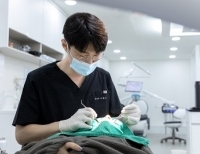Lymph Node Radiotherapy Emerges as the Preferred Treatment for Breast Cancer Patients with Positive Nodes
New treatment paradigm shows significantly fewer side effects
2014-05-08
medicalworldnews medical@medicalworldnews.co.kr
medicalworldnews medical@medicalworldnews.co.kr
Las Vegas--A groundbreaking prospective international study presented this week at the American Society of Breast Surgeons (ASBrS) Annual Meeting found that lymph node axillary radiotherapy (ART), an emerging treatment protocol for tumors affecting the lymph nodes, is associated with significantly fewer complications than traditional axillary lymph node dissection (ALND) or removal. The study was conducted by the European Organisation for Research and Treatment of Cancer (EORTC).
The 4806-patient trial found that at one year after treatment, lymphedema rates were 15% for the ART group, 25% for the ALND patients and 59% for those receiving both therapies. At five post-treatment, the condition was present in only 10% of ART patients, compared to 21% of those treated with ALND and 58% of the combination therapy group. Arm lymphedema is a debilitating condition involving lymph fluid retention and tissue swelling common among breast cancer patients following node dissection.
The study also found that the incidence of short-term side effects such as post-treatment infection, hemorrhage, early edema and persistent seroma among patients was 9% for the ART group and 23% for the ALND group. Arm paresthesia was observed in 9% of ART and 10% of ALND patients. The study was conducted between 2001 and 2010, with an average time to follow up of over six years.
“These are extremely important findings that may change surgical guidelines and offer better quality-of-life for many, many women. This is particularly true for younger patients, who would otherwise live with the difficult side effects of node surgery, such as lymphedema, for a long time,” comments lead researcher Mila Donker, MD, Netherlands Cancer Institute, Antoni van Leeuwenhoek Hospital. “The study involved almost 5,000 women from various countries with differing standards-of-care, so the study really reflects the real world clinical practice. It has important implications for treatment going forward.”
In the study, shoulder mobility decreased temporarily in both treatment groups, particularly during the first year. Those treated with more extensive ALND or specialized supraclavicular radiotherapy following surgery suffered greater mobility loss, compared to the ART group. However, women with less extensive ALND showed superior shoulder movement compared to the ART group one year after their procedure.
The authors conclude that for patients with positive sentinel nodes, ART is the preferred treatment over ALND given the overall morbidity. A combination of surgery and radiation increases side effects and should be avoided if possible.
“I believe that as a result of this trial, radiotherapy of the nodes will begin to replace surgery,” says Dr. Donker. “The results are that definitive and significant for patients’ quality-of-life.”



 [신경과 제대로 알기]반복되는 한쪽 머리 통증, 단순 두통이 아닐 수 있어
[신경과 제대로 알기]반복되는 한쪽 머리 통증, 단순 두통이 아닐 수 있어
 [치과에 대한 모든 것]대표적 성인 치아교정 ‘투명교정’ 특징과 주의점
[치과에 대한 모든 것]대표적 성인 치아교정 ‘투명교정’ 특징과 주의점
 [성형외과 시술 제대로 알기]‘매부리코’ 기능적인 부분까지 고려 필요
[성형외과 시술 제대로 알기]‘매부리코’ 기능적인 부분까지 고려 필요
 [치과에 대한 모든 것]치아은행 통한 치아 보존, 자가 골이식처럼 이용 가능
[치과에 대한 모든 것]치아은행 통한 치아 보존, 자가 골이식처럼 이용 가능
 [피부과 시술 제대로 알기]얼굴이 울긋불긋 ‘안면홍조와 주사피부염’ 차이점과 특징은?
[피부과 시술 제대로 알기]얼굴이 울긋불긋 ‘안면홍조와 주사피부염’ 차이점과 특징은?






